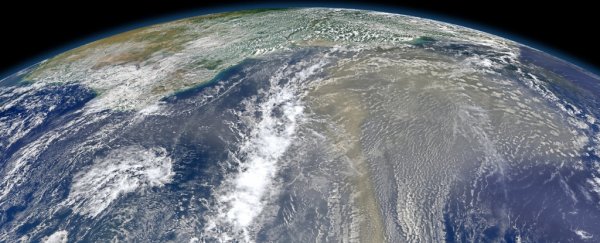Climate models are an invaluable tool for predicting the trajectory of the climate crisis, but we need them to be as accurate as possible if we're going to model everything from its pace, to its consequences, to its tipping points.
Now, it seems we need to adjust some numbers on the true dustiness of Earth's atmosphere - a property that plays a vital role in climate systems.
Comparing data from dozens of airborne observations throughout the world, a new study has found our planet's atmosphere contains about 17 million metric tonnes of coarse dust (which is larger than fine dust). This is four times more than is simulated in current climate models.
That's roughly the mass of every single person in the United States put together, and if that's really what's going on here, we have a lot of recalculating to do.
This tiny, invisible matter tends to warm the atmosphere a lot like greenhouse gases do, and yet in six widely-used global atmospheric simulations, most of that coarse dust appears to be missing.
"When we compared our results with what is predicted by current climate models, we found a drastic difference," says atmospheric and oceanic scientist Jasper Kok from the University of California Los Angeles.
"State-of-the-art climate models account for only 4 million metric tons, but our results showed more than four times that amount."
If they're right, that means these simulations aren't incorporating nearly enough dust. And this could have a big impact on many of Earth's systems, from the amount of carbon dioxide absorbed in the ocean to the volume of rain falling in, say, the tropics.
More dust being driven up into the atmosphere and more of it falling into the ocean, could lead to big changes in clouds, precipitation and climate.
Between Earth and the Sun, these coarse particles cop incoming radiation from both above and below. This can cause changes in atmospheric circulation, potentially driving phenomena like hurricanes, which have, incidentally, been increasing in frequency and severity with climate change.
What's more, if you add these new dust numbers into current climate models, the authors say it increases the likelihood of both fine and coarse particles contributing to a warming climate system, from the atmosphere above to the oceans below.
"Models have been an invaluable tool for scientists," says atmospheric and oceanic scientist Adeyemi Adebiyi from UCLA, "but when they miss most of the coarse dust in the atmosphere, it underestimates the impact that this type of dust has on critical aspects of life on Earth, from precipitation to cloud cover to ocean ecosystems to global temperature."
For instance, the researchers say when dust is around, air tends to act more turbulently, keeping it up in the atmosphere for longer, allowing them to travel further than many models give them credit for.
In 2018, in fact, researchers discovered that large particles of dust kicked up in the Sahara can ride on global winds to the Caribbean, 3,500 kilometres (2,000 miles) away. Measuring at 0.45 millimetres in diameter, these pieces of dust were nearly 50 times bigger than what global winds were once thought capable of carrying.
That astonishing idea is supported by this new research, albeit less directly.
"Since more coarse dust particles are present in the atmosphere, it also suggests that they have a longer lifetime than those simulated in global models," the authors write.
And yet today, many models have all this coarse dust fall out of the atmosphere far too quickly.
"To properly represent the impact of dust as a whole on the Earth system, climate models must include an accurate treatment of coarse dust in the atmosphere," says Adebiyi.
Our climate models are constantly being updated as we learn more about our planet, and this is just one aspect that seems to need a makeover. With the new information available, we'll be better equipped to determine Earth's future.
The study was published in Science Advances.

